Analysis of Granite Deformation and Rupture Law and Evolution of Grain-Based Model Force Chain Network under Anchor Reinforcement
Abstract
:1. Introduction
2. Research Methods
2.1. Uniaxial Compression Test
2.2. Construction of Continuous-Discrete Coupled Numerical Models
2.3. Quantitative Analysis and Representation of Force Chain Network
2.4. Effectiveness Verification of Numerical Model
3. Macroscopic Mechanical Properties
3.1. Mechanical Parameters
3.2. Macroscopic Rupture Models
- (1)
- Comparison of displacement field features
- (2)
- Comparison of fragmentation fields
4. Analysis of Force Chain Network Characteristics in Anchored Granite with Different Fissure Angles
5. Discussion
5.1. Effect of Fissure Angles on Crack Distribution
5.2. Effect of Fissure Angles on the Force Chain Values
6. Conclusions
- (1)
- It was found that there is a strong consistency in the trend of load–displacement results between experimental and simulation results. The macroscopic fracture patterns of unanchored samples all show obvious shear failure, with debris fields concentrated at the fracture tips and distributed along the diagonal of the samples, while the distribution of debris in anchored samples is more uniform. This, in turn, validates the effectiveness of the numerical model parameter calibration.
- (2)
- The number of force chains, the average force chain value, and the total force chain count within the anchored samples all exceed those of the unanchored samples. This suggests that there are fewer cementation fractures within the anchored samples, which implies fewer cracks. Furthermore, as the αs increase, the increase in force chain characteristics of the anchored samples compared to the unanchored samples decreases.
- (3)
- The results show that the volume of the three-dimensional rose diagrams of the anchored samples with fractures at various dips is greater than that of the unanchored samples. As the αs increase, the above phenomenon becomes less apparent, which means that the anchored samples have a higher load-bearing capacity. In addition, as αs increase, the anchoring reinforcement effect of the rock bolts becomes less obvious.
- (4)
- A quantitative exploration was conducted on the anchoring and crack-stopping effect of rock bolts on granite samples with different dip angles of fractures. The results show that at αs = 30°, the rock bolts have the best crack-stopping effect on the samples. As αs increases, the crack-stopping effect gradually weakens and becomes less apparent. This suggests that in practical engineering, when dealing with fractured rock masses under different working conditions, targeted anchoring and support measures can be applied. This approach can help reduce costs to a certain extent.
Author Contributions
Funding
Institutional Review Board Statement
Informed Consent Statement
Data Availability Statement
Conflicts of Interest
References
- Kang, H.P.; Gao, F.Q. Evolution of Mining-Induced Stress and Strata Control in Underground Coal Mines. Chin. J. Rock Mech. Eng. 2024, 43, 1–40. [Google Scholar]
- Jiao, K.J.; Fang, Q.B. Optimization Design Study of Bolt Support for Tunnel with High Ground Stress and Steep Bedding Surrounding Rock. Chin. J. Undergr. Space Eng. 2019, 19 (Suppl. S2), 813–818. [Google Scholar]
- Zhao, L.L.; Yang, W.B.; Pan, W.T.; Wu, F.Y.; Wang, Z.L.; Yang, Z.C. Study on model test and numerical simulation of layered soft rock tunnel construction with different large deformation grades. Chin. J. Rock Mech. Eng. 2024, 43, 454–467. [Google Scholar]
- Long, J.K.; Zu, Z.Y.; Wang, Y.S.; Luo, W.D. Experimental Study on Linkage anchorage Technique of the prestressed anchors. J. Min. Saf. Eng. 2012, 29, 662–667. [Google Scholar]
- Chen, W.Z.; Wang, L.Y.; Tan, X.J.; Yang, D.S.; Yuan, J.Q.; Yang, J.P. State-of-the-art and development tendency of the underground engineering stability of fractured rock mass. Chin. J. Rock Mech. Eng. 2021, 40, 1945–1961. [Google Scholar]
- Bjurstrom, S. Shear Strength of Hard Rock Joints Reinforced by Grouted Un-Tensioned Bolts. In Proceedings of the 3rd International Congress on Rock Mechanics, Denver, CO, USA, 1–7 September 1974; Volume 2, pp. 1194–1199. [Google Scholar]
- Littlejohn, G.S.; Bruce, D.A. Rock Anchors: State-of-the-Art Part I, Design, Ground Engineering; Foundation Publications Ltd.: London, UK, 1975; pp. 163–175. [Google Scholar]
- Egger, P.; Spang, K. Stability Investigations for Ground Improvement by Rock Bolt at a Large Dam. In Proceedings of the VI International Conference ISRM, Montreal, QC, Canada, 30 August–3 September 1987; pp. 349–354. [Google Scholar]
- Spang, K.; Egger, P. Action of fully-grouted bolt in jointed rock and factors of influence. Rock Mech. Rock Eng. 1990, 23, 201–229. [Google Scholar] [CrossRef]
- Bezuijen, A. Compensation Grouting in Sand: Experiments, Field Experiences and Mechanisms. Ph.D. Thesis, Delft University of Technology, Delft, The Netherlands, 2010. [Google Scholar]
- Chen, Y. Experimental study and stress analysis of rock bolt anchorage performance. J. Rock Mech. Geotech. Eng. 2014, 6, 428–437. [Google Scholar] [CrossRef]
- Zong, Y.J.; Han, L.J.; Qu, T.; Yang, S.Q. Mechanical properties and failure characteristics of fractured sandstone with grouting and anchorage. Int. J. Min. Sci. Technol. 2014, 24, 165–170. [Google Scholar] [CrossRef]
- Ren, M.Y.; Zhang, Q.Y.; Chen, S.Y.; Zhang, L.Y.; Xiang, W. Experimental study on mechanical properties of anchored rock-like material with weak interlayer under uniaxial compression. Geotech. Geol. Eng. 2020, 38, 4545–4556. [Google Scholar] [CrossRef]
- Ding, S.; Gao, Y.; Jing, H.; Shi, X.; Qi, Y.; Guo, J. Influence of weak interlayer on the mechanical performance of the bolted rock mass with a single free surface in deep mining. Minerals 2021, 11, 496. [Google Scholar] [CrossRef]
- Li, Y.; Zhou, H.; Zhang, L.; Zhu, W.S.; Li, S.C.; Liu, J. Experimental and numerical investigations on mechanical property and reinforcement effect of bolted jointed rock mass. Constr. Build. Mater. 2016, 126, 843–856. [Google Scholar] [CrossRef]
- Yang, W.D.; Luo, G.Y.; Bo, C.J.; Wang, L.; Lü, X.X.; Wang, Y.N.; Wang, X.P. Mechanical properties and reinforcement effect of jointed rock mass with pre-stressed bolt. J. Cent. South Univ. 2020, 27, 3513–3530. [Google Scholar] [CrossRef]
- Yang, S.Q.; Chen, M.; Huang, Y.H.; Jing, H.W.; Ranjith, P.G. An experimental study on fracture evolution mechanism of a non-persistent jointed rock mass with various anchorage effects by DSCM, AE and X-ray CT observations. Int. J. Rock Mech. Min. Sci. 2020, 134, 104469. [Google Scholar] [CrossRef]
- Li, Y.Z.; Tannant, D.D.; Pang, J.Y.; Su, G.S. Experimental and analytical investigation of the shear resistance of a rock joint held by a fully-grouted bolt and subject to large deformations. Transp. Geotech. 2021, 31, 100671. [Google Scholar] [CrossRef]
- Zhang, T. Investigation of Microscopic Mechanism of Fracture Process of Granite Based on Three-Dimensional GBM and Multi-Level Force Chain Network; China University of Mining and Technology: Xuzhou, China, 2023. [Google Scholar]
- Li, W.; Yu, L.Y.; Zhang, T.; Su, H.J.; Mi, X.Z.; Fan, D.D.; Jin, B. Quantitative Analysis of Grain Size Effect on Tensile Mechanical Behavior of Granite Based on Multi-Level Force Chain Networks. Comput. Part. Mech. 2024, in press. [CrossRef]
- Han, G.S.; Jing, H.W.; Zhu, T.T.; Su, H.J. Study on numerical simulation of effect of rock mass fracture on load transfer mechanism of rockbolt. Coal Technol. 2015, 34, 45–48. [Google Scholar]
- Kang, Z.Q.; Zhang, X.Y.; Zhao, J.M.; Zhang, S.Q. Effects of “S” type fractured rock anchoring and the distribution rule of stress field. Met. Mines. 2014, 1, 46–49. [Google Scholar]
- Saadat, M.; Taheri, A. A numerical approach to investigate the effects of rock texture on the damage and crack propagation of a pre-cracked granite. Comput. Geotech. 2019, 111, 89–111. [Google Scholar] [CrossRef]
- Wu, D.Y.; Yu, L.Y.; Su, H.J.; Wu, J.Y.; Liu, R.C.; Zhou, J. Experimental study and PFC3D simulation on crack propagation of fractured rock-like specimens with bolts under uniaxial compression. Rock Soil Mech. 2021, 42, 1681–1692. [Google Scholar]
- Chen, M. Study on the Deformation Failure behavior and Reinforcement Effect of Bolts of Non-Persistent Jointed Rock; China University of Mining and Technology: Xuzhou, China, 2019. [Google Scholar]
- Xu, Y.; Dai, F.; Xu, N.W.; Zhao, T. Numerical investigation of dynamic rock fracture toughness determination using a semi-circular bend sample in split Hopkinson pressure bar testing. Rock Mech. Rock Eng. 2016, 49, 731–745. [Google Scholar] [CrossRef]
- Huang, Y.H.; Yang, S.Q.; Ranjith, P.G.; Zhao, J. Strength failure behavior and crack evolution mechanism of granite containing pre-existing non-coplanar holes: Experimental study and particle flow modeling. Comput. Geotech. 2017, 88, 182–198. [Google Scholar] [CrossRef]
- Zhang, X.P.; Wang, G.; Jiang, Y.J.; Wu, X.Z.; Wang, Z.C.; Huang, N. Simulation research on granite compression test based on particle discrete element model. Rock Soil Mech. 2014, 35, 99–105. [Google Scholar]
- Du, H.B.; Dai, F.; Xu, Y.; Liu, Y.; Xu, H.N. Numerical investigation on the dynamic strength and failure behavior of rocks under hydrostatic confinement in SHPB testing. Int. J. Rock Mech. Min. Sci. 2018, 108, 43–57. [Google Scholar] [CrossRef]
- Zhang, Y.; Ding, Z.Q.; Fang, C.; Cong, B.T. Three-dimensional Discrete Element Simulation on Macro-Micro Mechanical Properties of Granite under Triaxial Cyclic Loading and Unloading. Min. Res. Dev. 2019, 39, 149–156. [Google Scholar]
- Cowie, S.; Walton, G. The effect of mineralogical parameters on the mechanical properties of granitic rocks. Eng. Geol. 2018, 240, 204–225. [Google Scholar] [CrossRef]
- Luo, X.Y.; Cao, P.; Liu, T.Y.; Zhao, Q.X.; Meng, G.; Fan, Z.; Xie, W.P. Mechanical behaviour of anchored rock containing weak interlayer under uniaxial compression: Laboratory test and coupled DEM-FEM Simulation. Minerals 2022, 12, 492. [Google Scholar] [CrossRef]
- Fan, D.D.; Zhang, T.; Yu, L.Y.; Hu, L.H.; Su, H.J.; Wei, J.B. A numerical study based on GBM3D-DEM model: Multi-level force chain analysis in dynamic flexural tensile strength test. J. Cent. South Univ. 2023, 30, 3821–3839. [Google Scholar] [CrossRef]
- Peng, Y.X.; Zhang, T.; Yu, L.Y.; Li, J.; Gao, Y.A.; Tian, W.L. Numerical investigation on the effect of intergranular contact bonding strength on the mechanical properties of granite using PFC3D-GBM. Int. J. Numer. Anal. Methods Geomech. 2023, 47, 694–716. [Google Scholar] [CrossRef]
- Potyondy, D.O.; Cundall, P.A. A bonded-particle model for rock. Int. J. Rock Mech. Min. Sci. 2004, 41, 1329–1364. [Google Scholar] [CrossRef]
- Potyondy, D.O. The bonded-particle model as a tool for rock mechanics research and application: Current trends and future directions. Geosyst. Eng. 2015, 18, 1–28. [Google Scholar] [CrossRef]
- Peng, J.; Wong, L.N.Y.; Teh, C.I.; Li, Z.H. Modeling micro-cracking behavior of Bukit Timah granite using grain-based model. Rock Mech. Rock Eng. 2018, 51, 135–154. [Google Scholar] [CrossRef]
- Li, X.F.; Zhang, Q.B.; Li, H.B.; Zhao, J. Grain-based discrete element method (GB-DEM) modelling of multi scale fracturing in rocks under dynamic loading. Rock Mech. Rock Eng. 2018, 51, 3785–3817. [Google Scholar] [CrossRef]
- Tian, W.L.; Yang, S.Q.; Huang, Y.H. Particle flow analysis of mechanical behavior and meso-mechanism of sandstone under unloading conditions. Rock Soil Mech. 2016, 37, 775–782. [Google Scholar]
- Zhang, L. Numerical simulations of the direct shear test. Chem. Eng. Technol. 2003, 26, 109–228. [Google Scholar]
- Leśniewska, D.; Nitka, M.; Tejchman, J.; Pietrzak, M. Contact force network evolution in active earth pressure state of granular materials: Photo-elastic tests and DEM. Granul. Matter 2020, 22, 71. [Google Scholar] [CrossRef]
- Wang, S.D.; Miao, Y.H.; Wang, L.B. Effect of grain size composition on mechanical performance requirement for particles in aggregate blend based on photoelastic method. Constr. Build. Mater. 2023, 363, 129808. [Google Scholar] [CrossRef]
- Zhang, T.; Yu, L.Y.; Peng, Y.X.; Jing, H.W.; Su, H.J.; Wei, J.B. Effect of the mineral spatial distribution heterogeneity on the tensile strength of granite: Insights from PFC3D-GBM numerical analysis. J. Rock Mech. Geotech. Eng. 2023, 15, 1144–1160. [Google Scholar] [CrossRef]
- Zhang, T.; Yu, L.Y.; Wu, B.B.; Tan, Y.Z.; Su, H.J.; Zhou, L.J. Influence of grain-to-particle size ratio on the tensile mechanical response of granite based on a novel three-dimensional grain-based model. Eng. Fract. Mech. 2022, 29, 108161. [Google Scholar] [CrossRef]
- Wang, G.; Yuan, K.; Jiang, Y.J.; Wu, X. Macro-micro mechanical on joint -grout-bolt interaction in rockmass subjected to shear loading. J. Cent. South Univ. Sci. Technol. 2015, 46, 2207–2215. [Google Scholar]
- Huang, Y.H.; Yang, S.Q.; Tian, W.L.; Wu, S.Y. Experimental and DEM study on failure behavior and stress distribution of flawed sandstone samples under uniaxial compression. Theor. Appl. Fract. Mech. 2022, 118, 103266. [Google Scholar] [CrossRef]
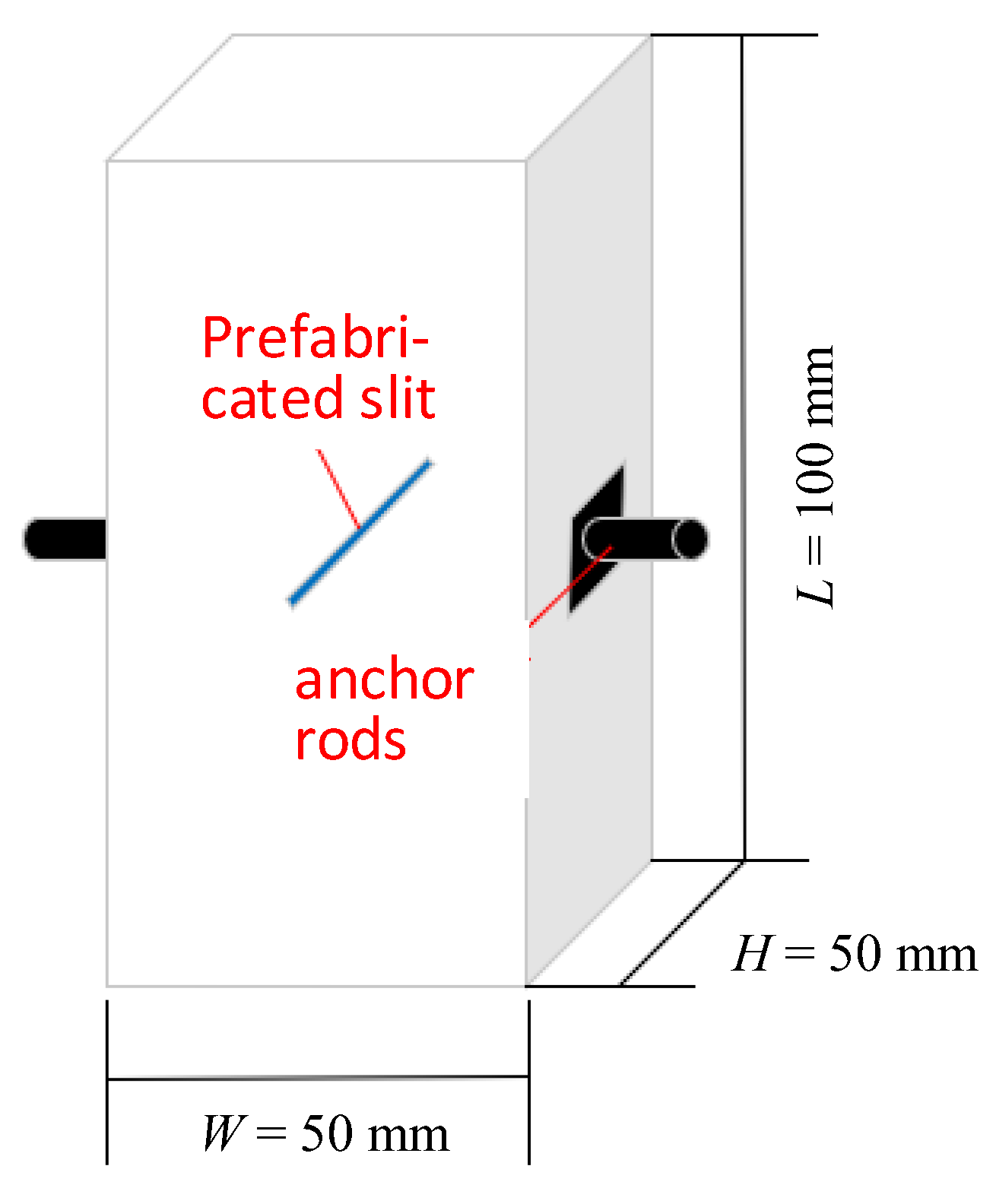
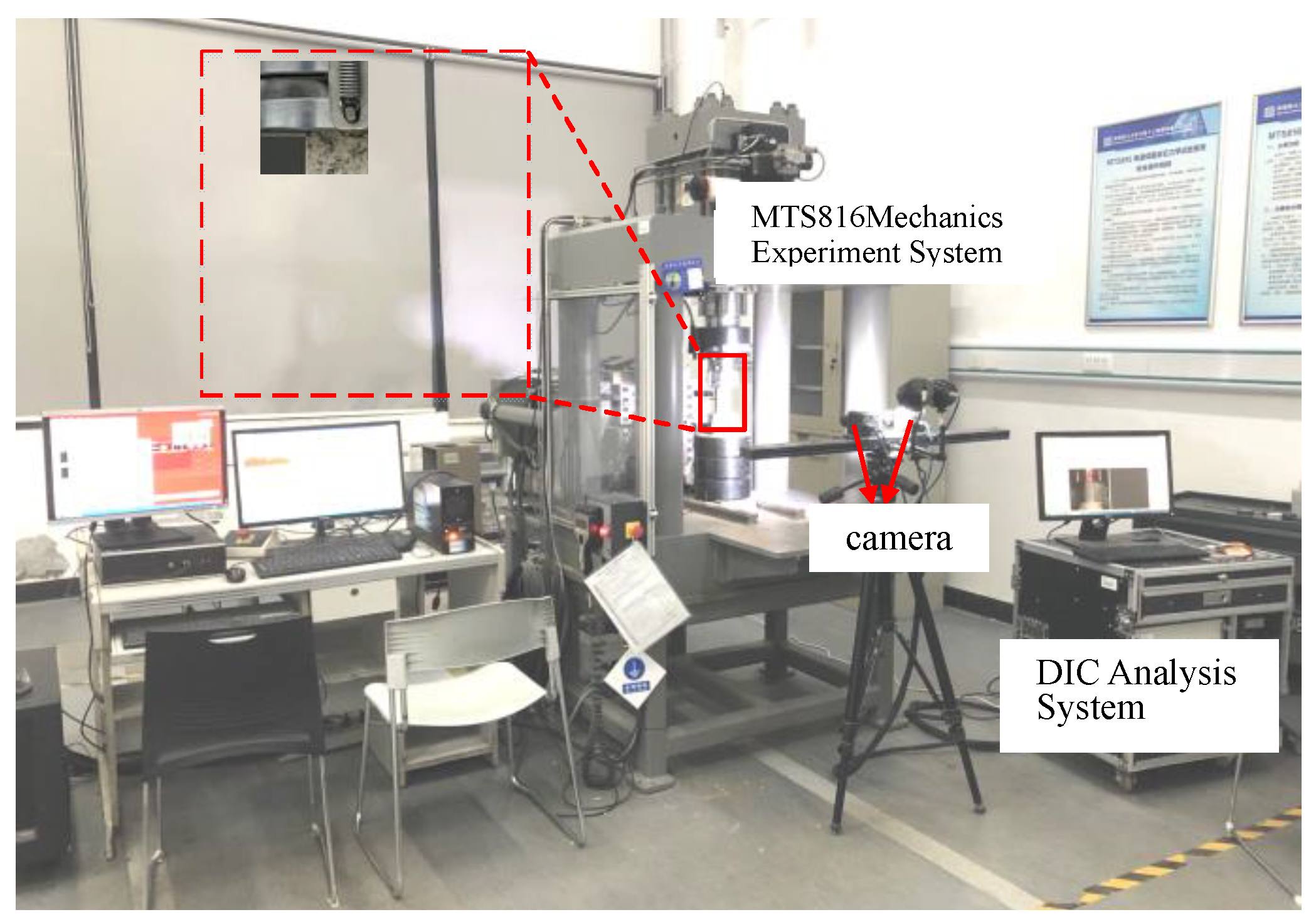

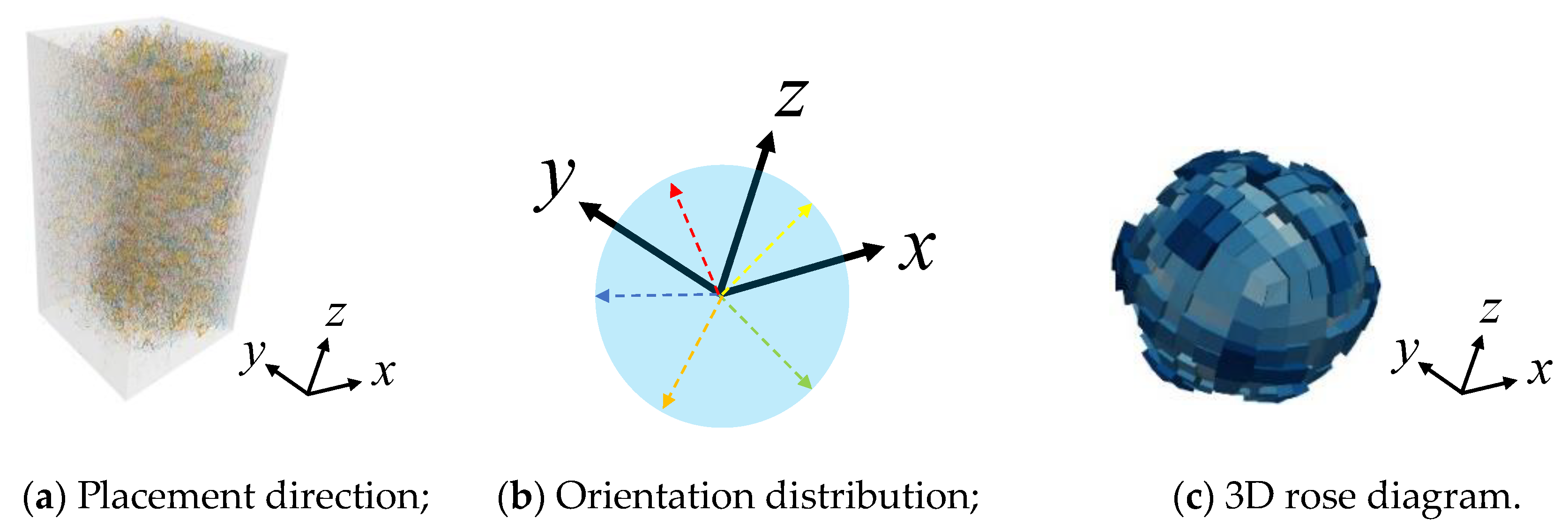
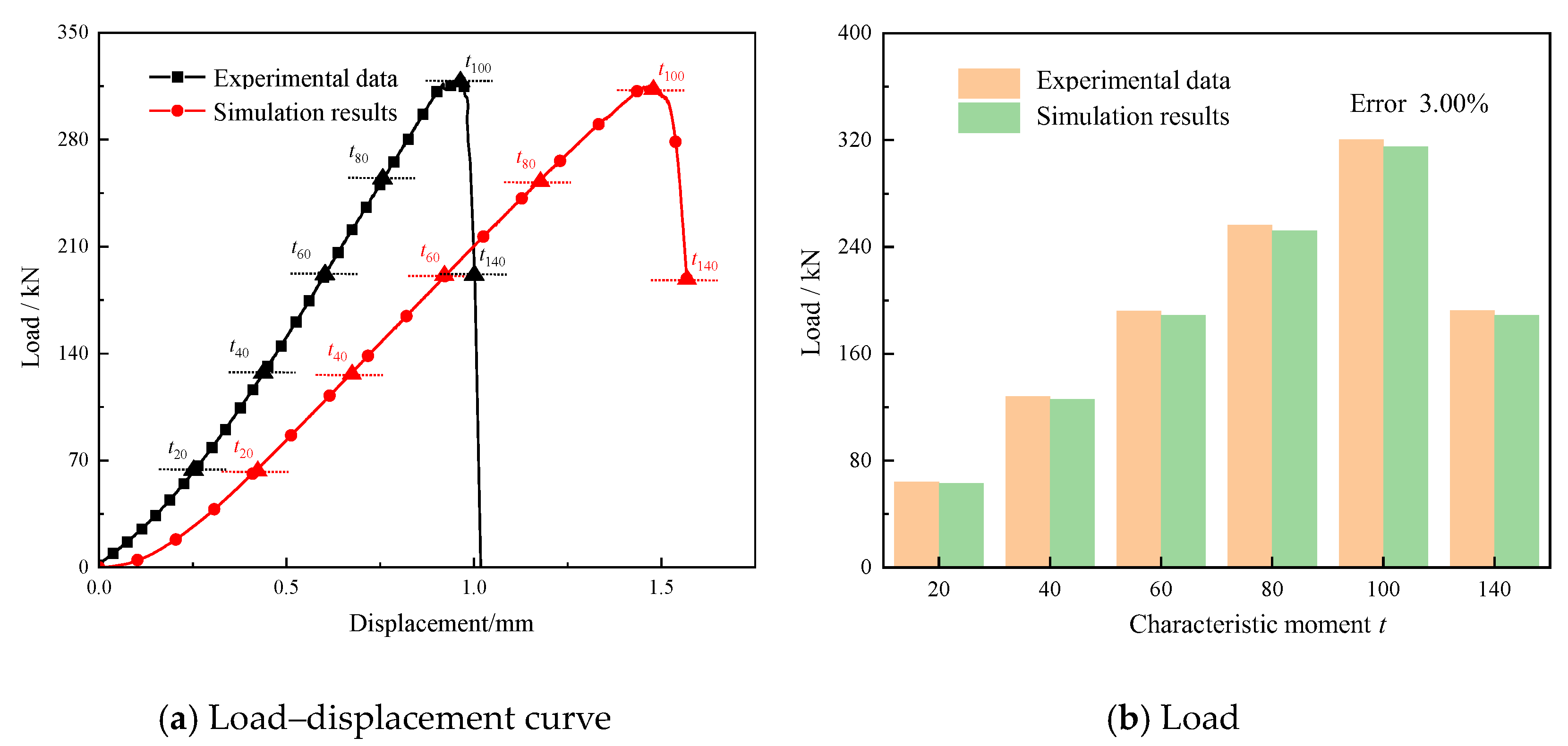
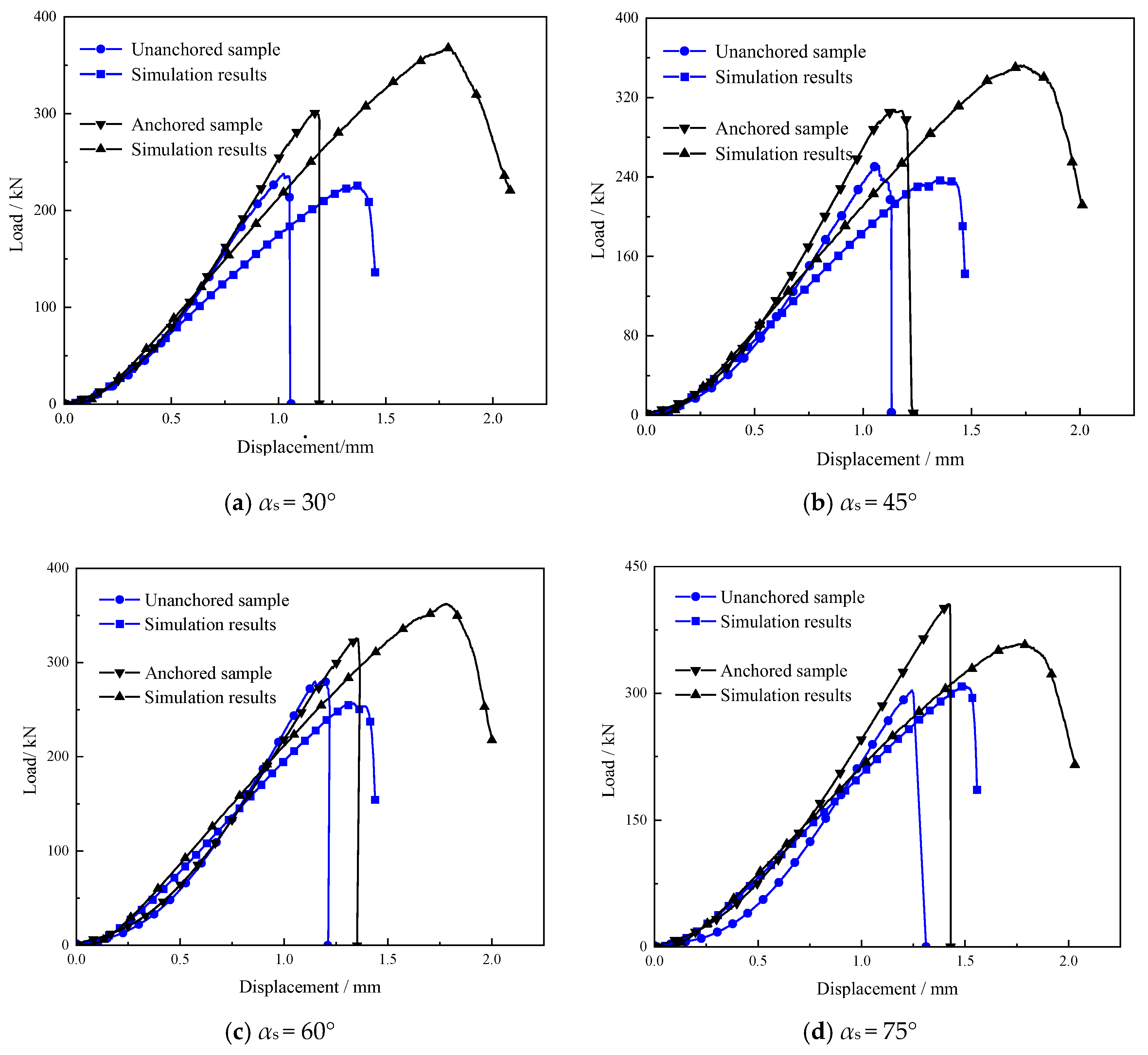
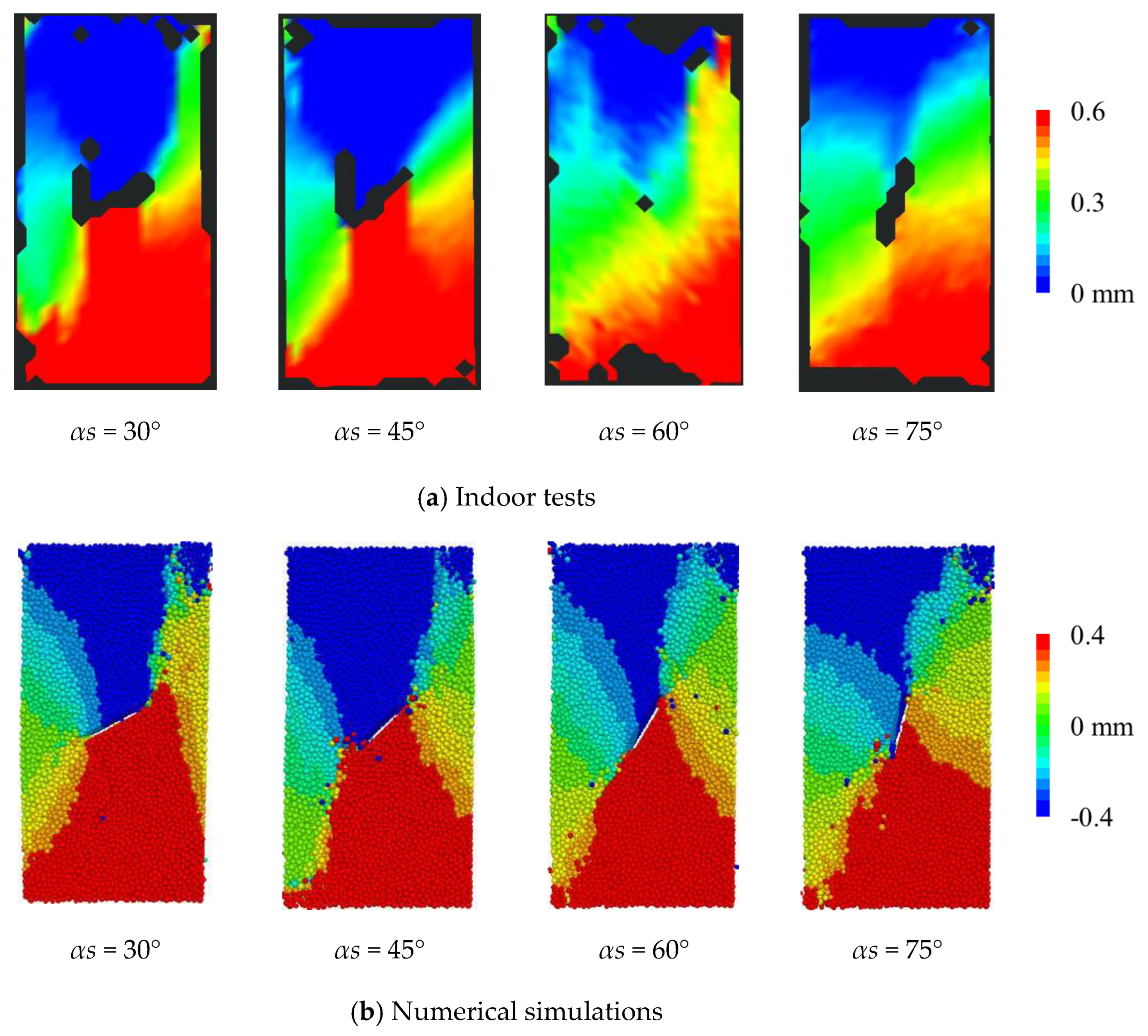
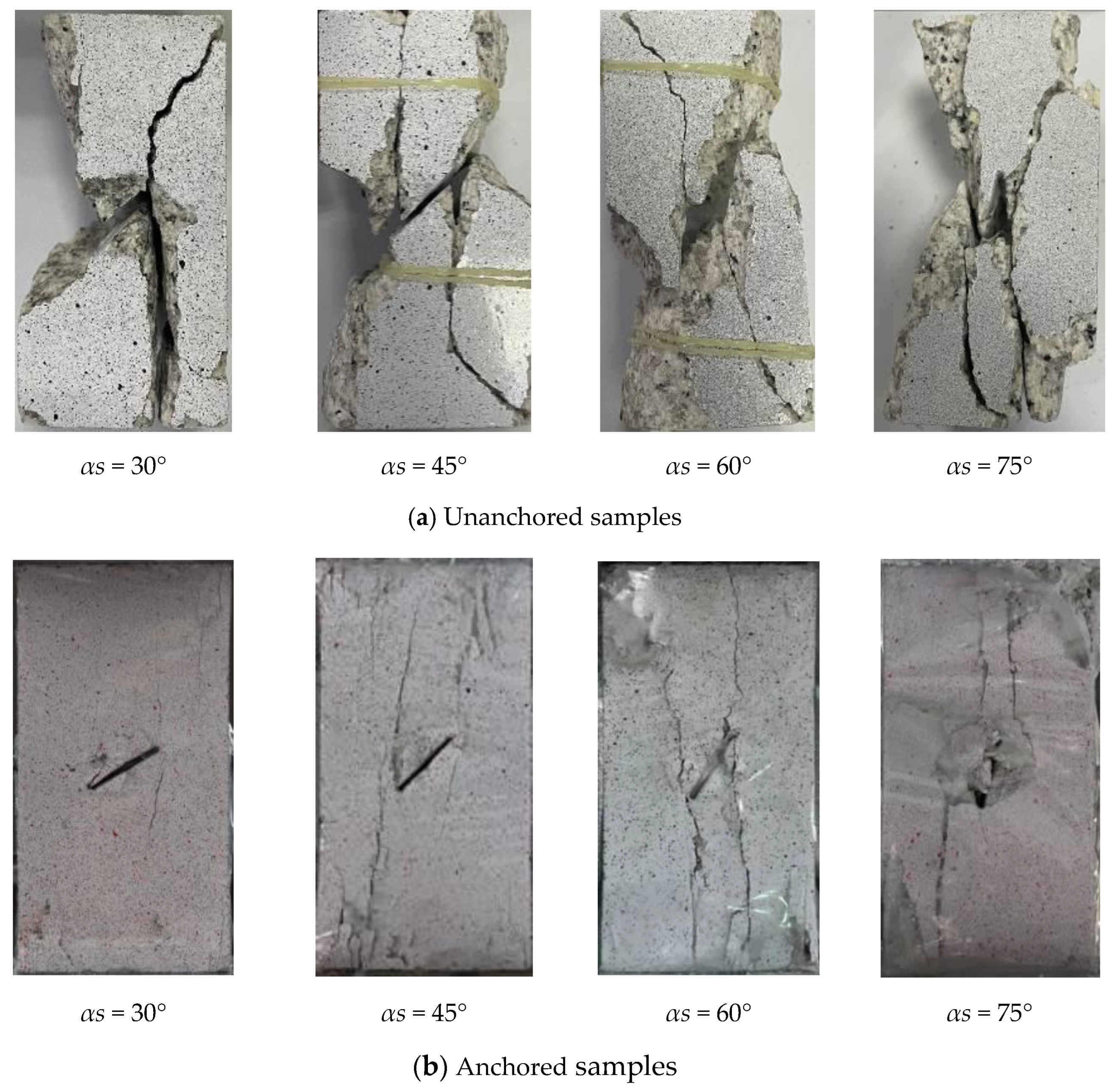
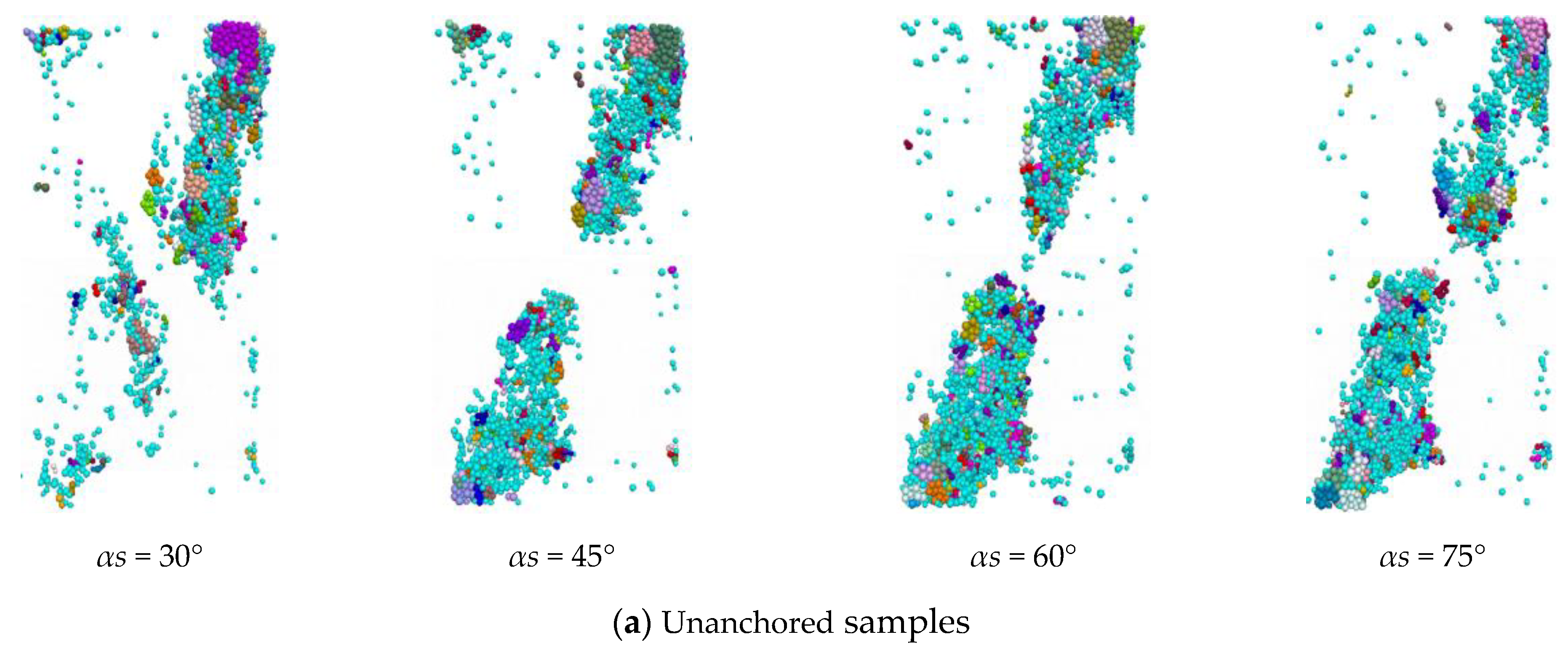
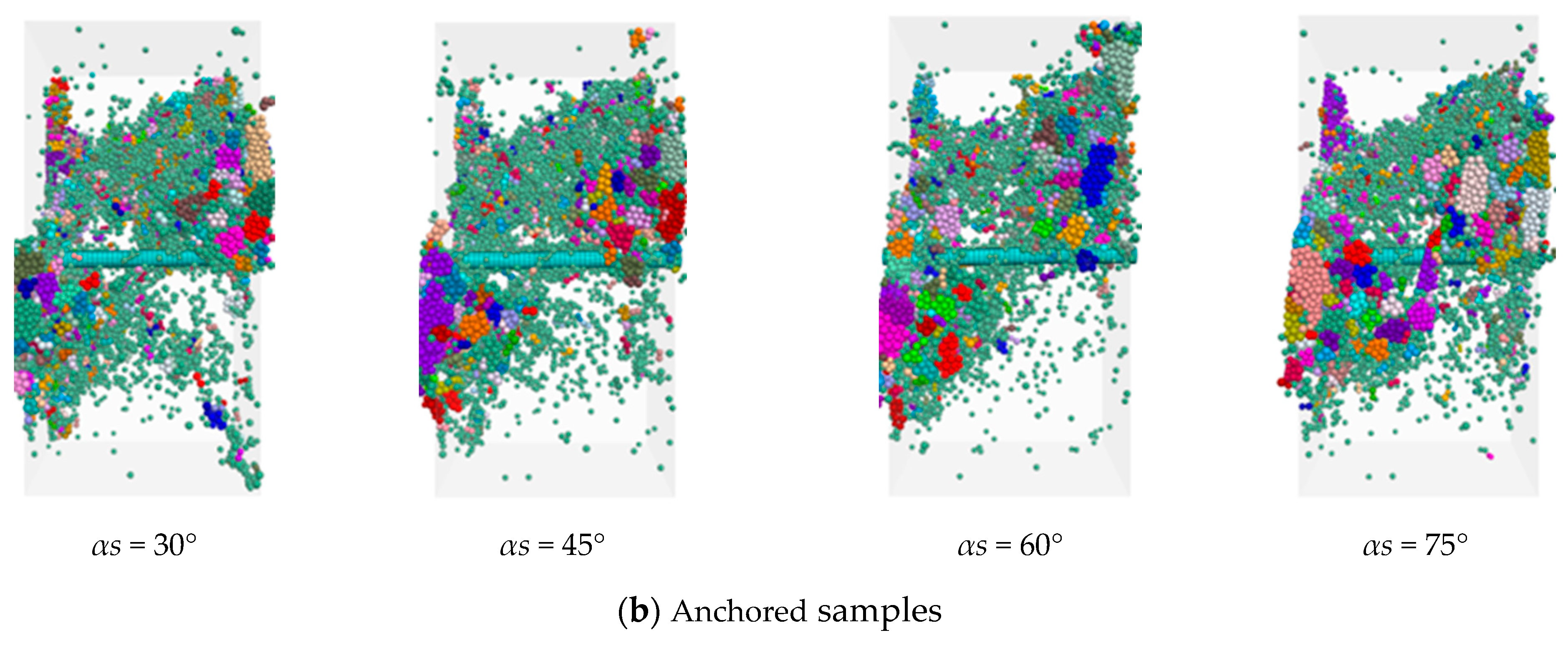
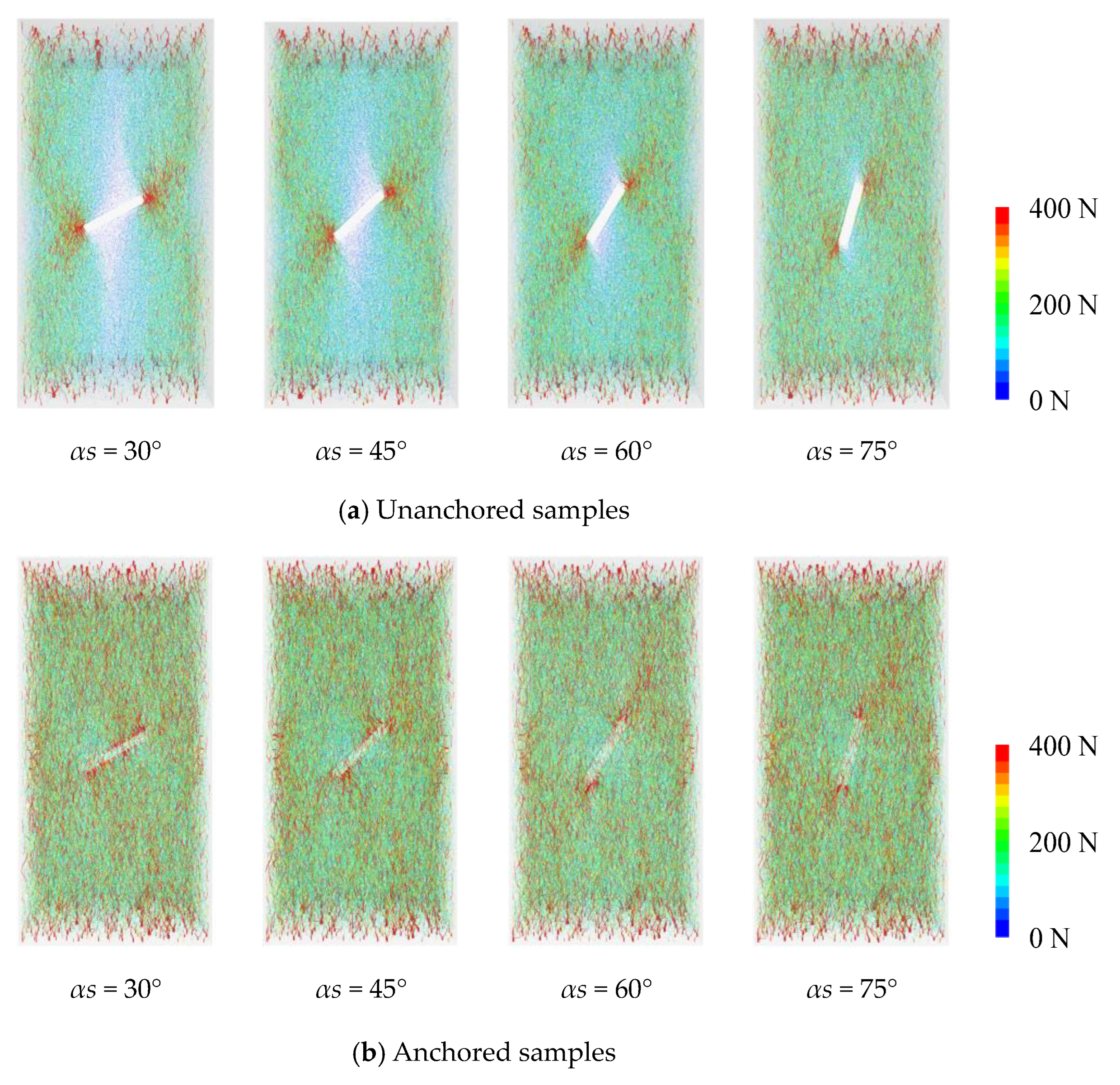
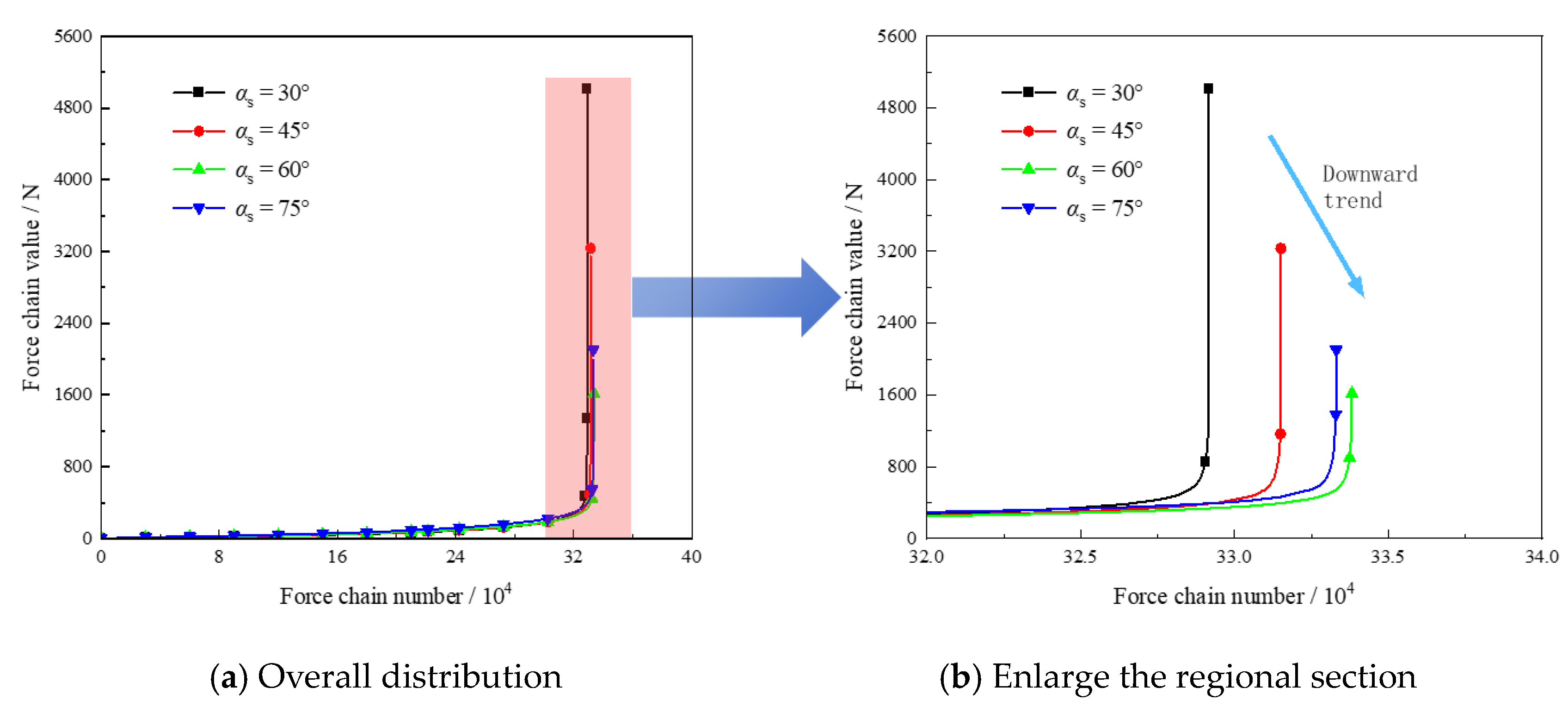
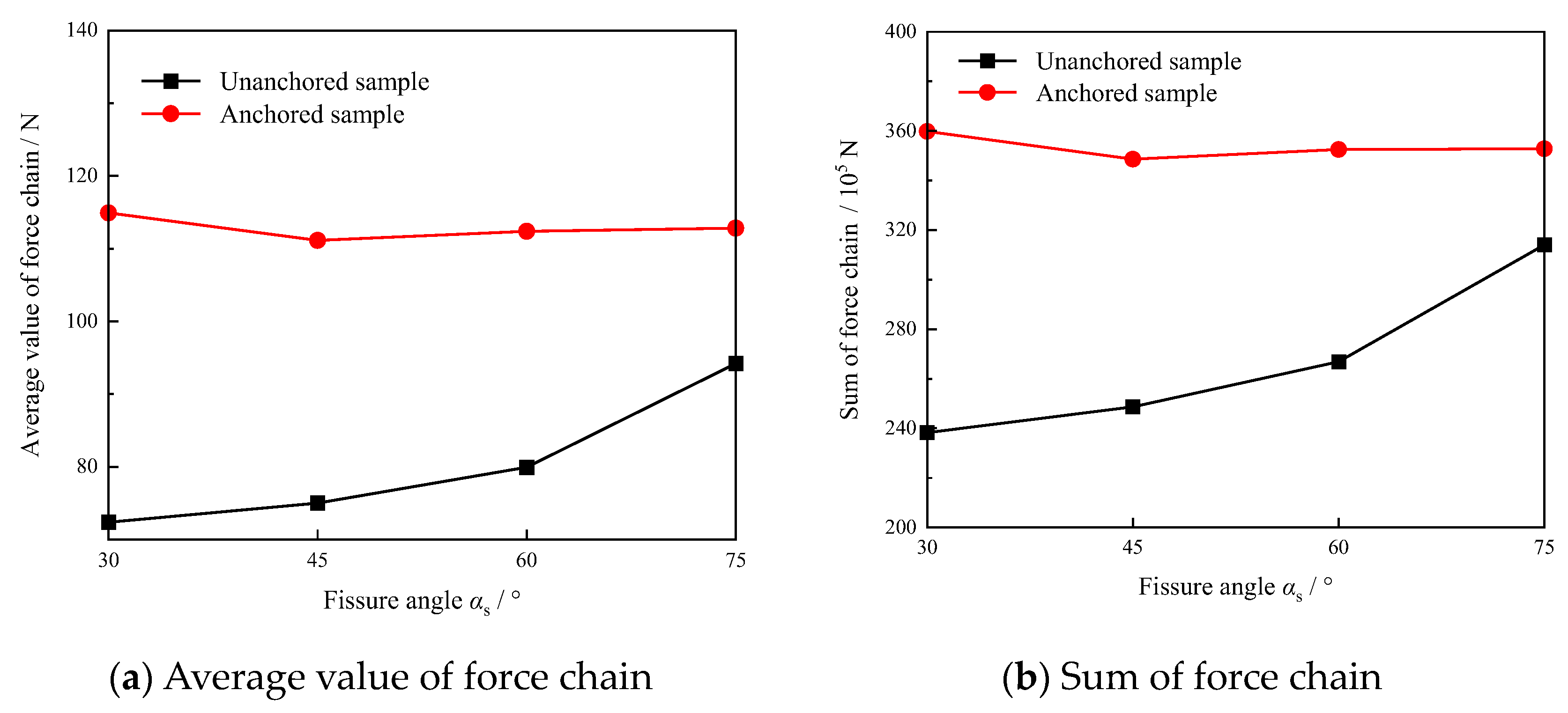

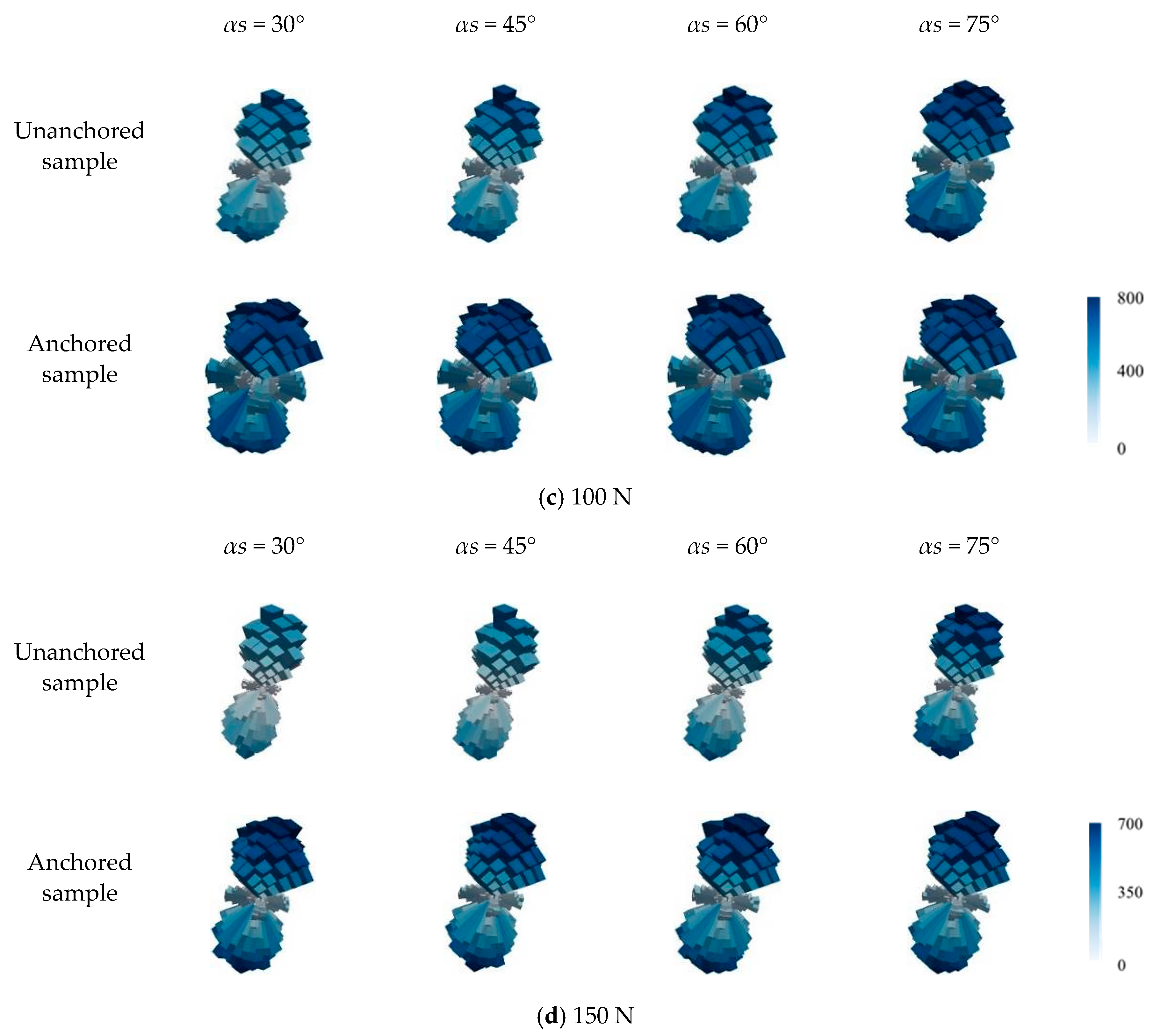
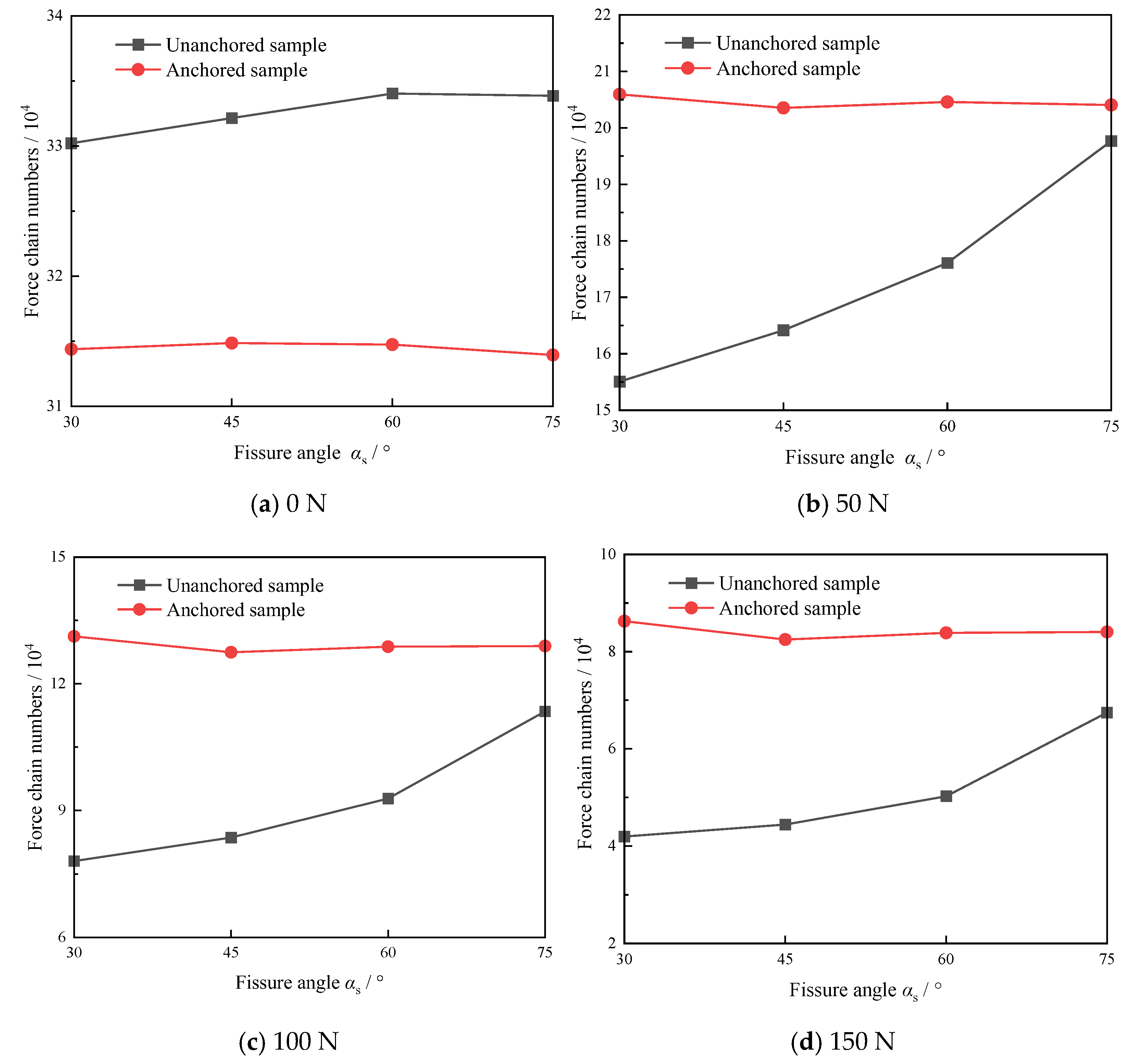
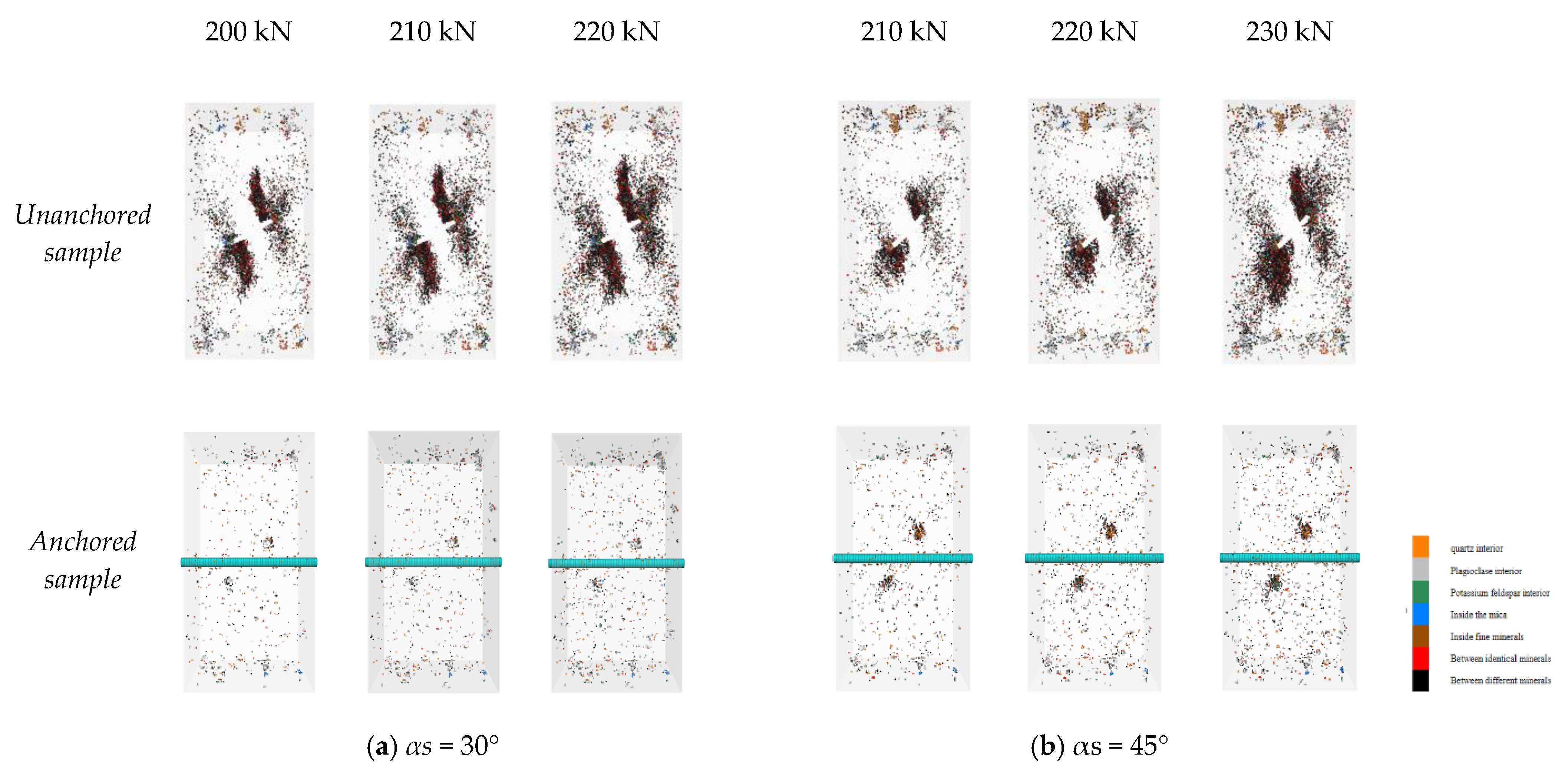
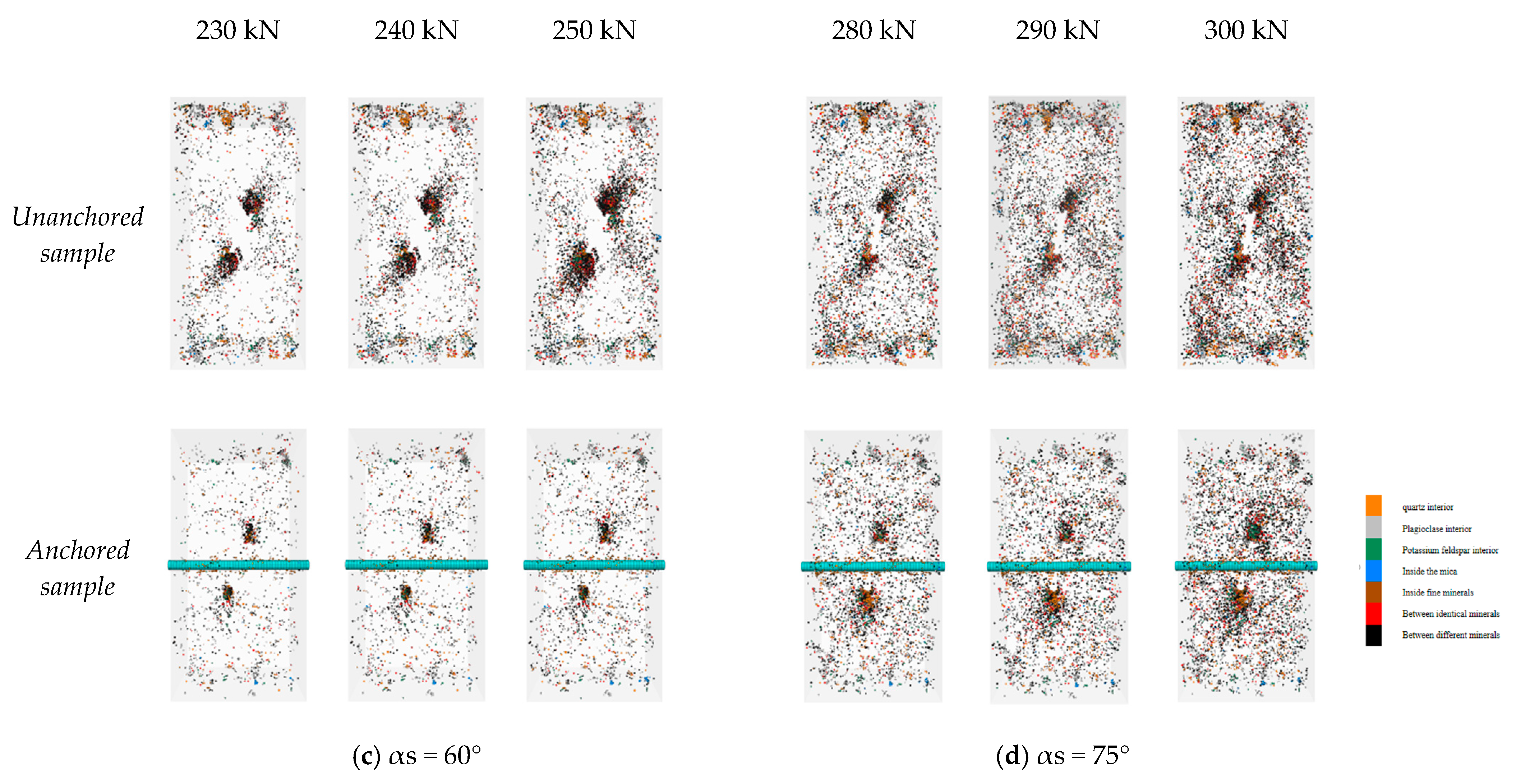
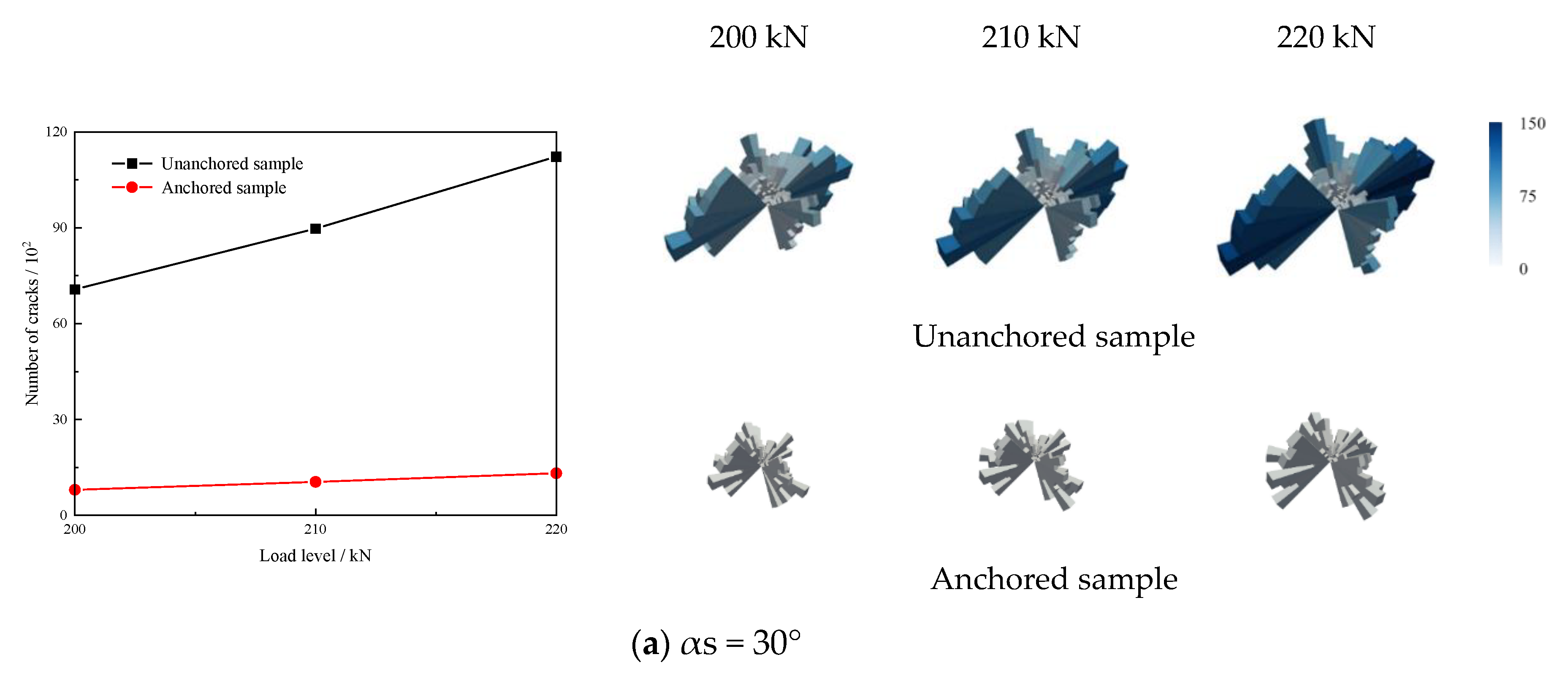
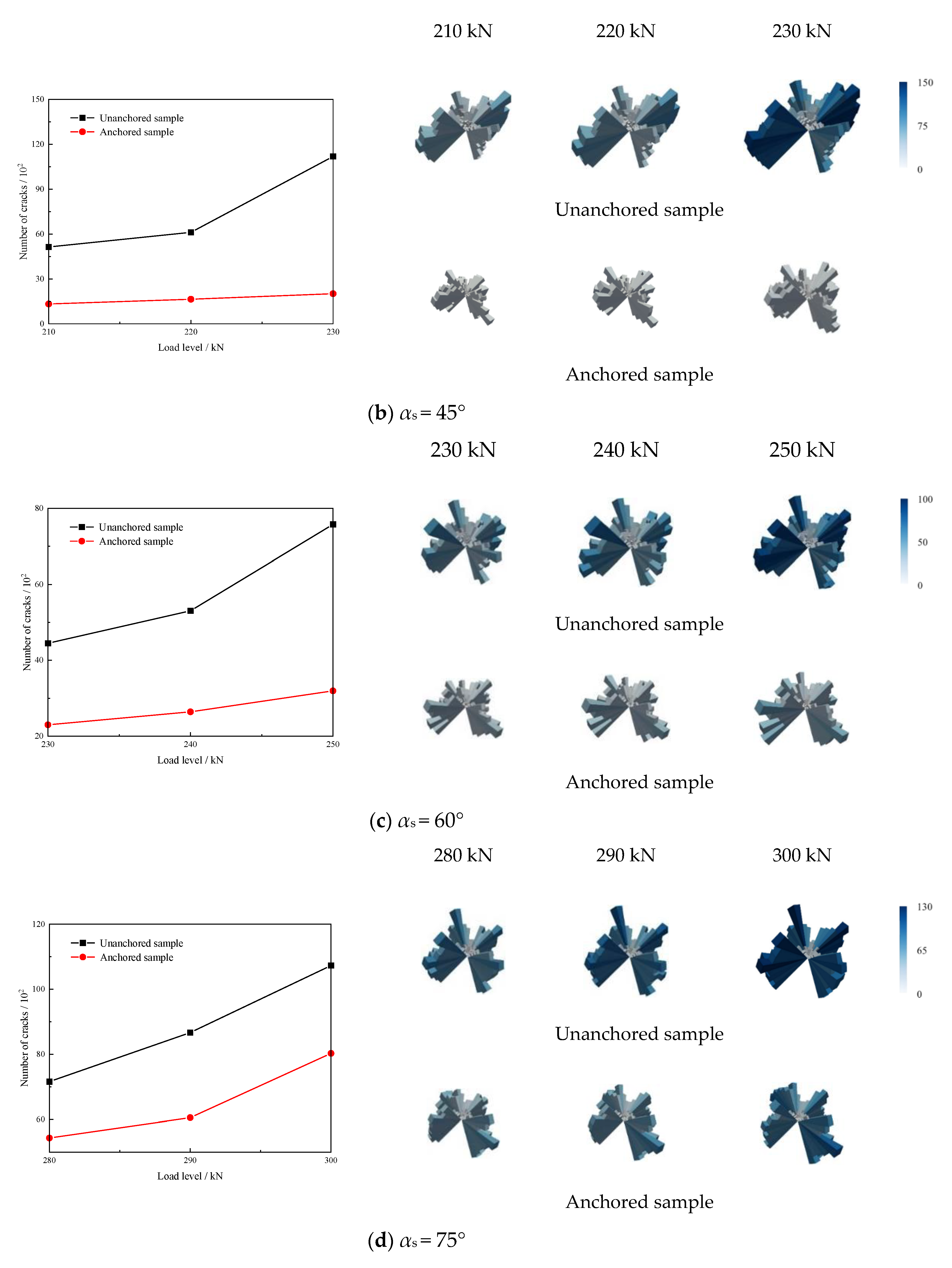
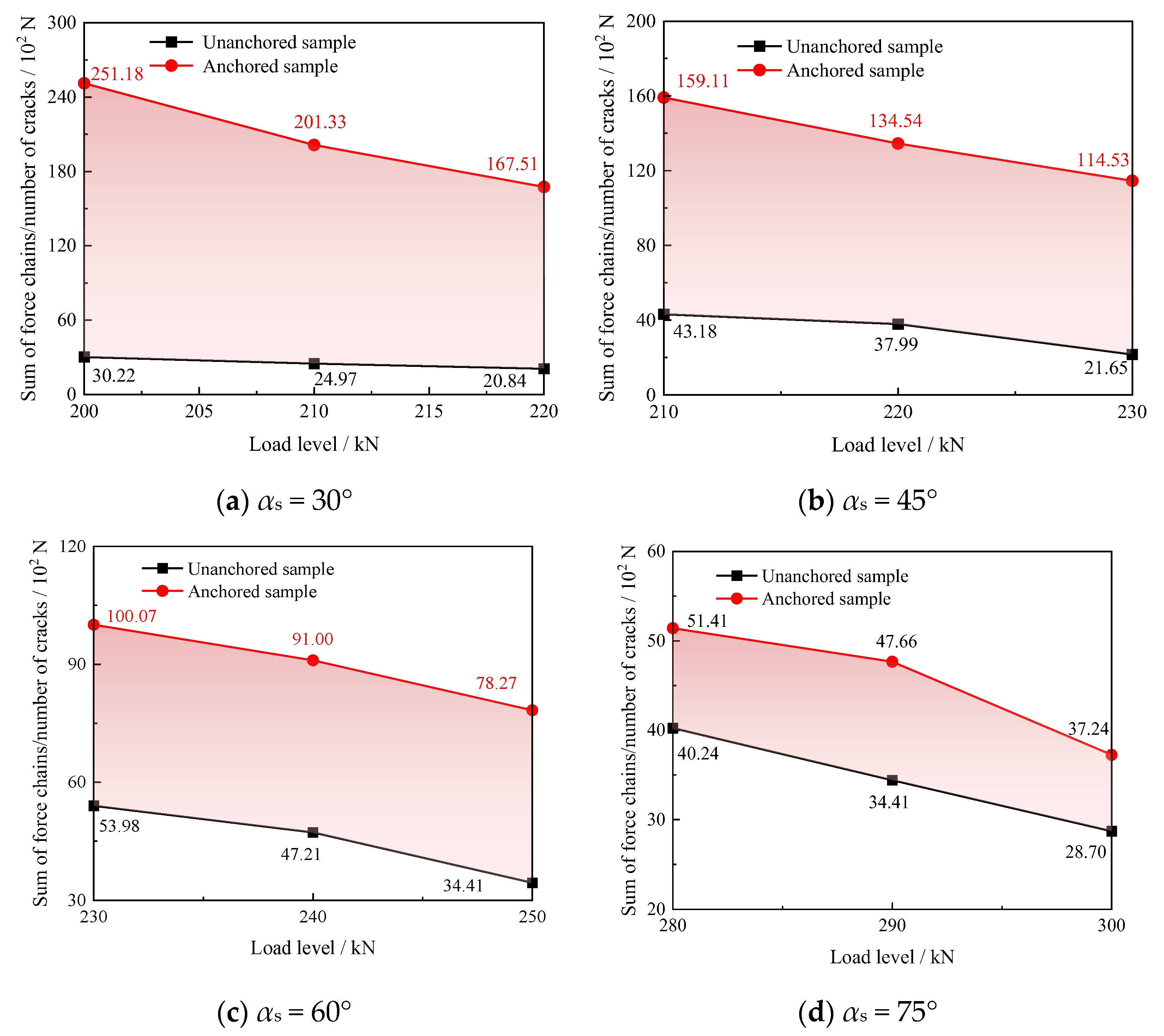
| Microscopic Parameter | Numerical Value | ||||
|---|---|---|---|---|---|
| Mineralogical composition | Sapphire | Plagioclase | Potassium feldspar | Micas | Fine mineral |
| Percentage by volume/% | 29.4 | 42.2 | 21.9 | 2.6 | 4.0 |
| Mineral Radius Minimum RG/mm | 1.8 | 1.4 | 1.6 | 1.2 | 0.65 |
| Mineral radius maximum to minimum ratio rG | 2.0 | ||||
| Basic unit | Sapphire | Plagioclase | Potassium feldspar | Micas | Fine mineral |
| Radius minimum Rp/mm | 0.65 | ||||
| Ratio of maximum to minimum radius rp | 2.0 | ||||
| Density ρp/kg/m3 | 2600 | 2650 | 3000 | 1700 | 2400 |
| Modulus of elasticity Ep/GPa | 62.0 | 47.0 | 32.0 | 27.0 | 22.0 |
| Rigidity ratio kn-p/ks-p | 1.4 | 1.6 | 1.8 | 2.0 | 2.2 |
| Friction factor μp | 0.25 | 0.30 | 0.40 | 0.50 | 0.60 |
| Intracrystalline contact | Quartz inner | Plagioclase | Potassium feldspar | Mica | Inside the fine minerals |
| Modulus of elasticity Ec-tra/GPa | 62.0 | 47.0 | 32.0 | 27.0 | 22.0 |
| Rigidity ratio kn-tra/ks-tra | 1.4 | 1.6 | 1.8 | 2.0 | 2.2 |
| Angle of internal friction ϕtra/° | 12 | 14 | 16 | 18 | 22 |
| Bonding strength ctra/MPa | 366.0 | 306.0 | 286.0 | 246.0 | 106.0 |
| Tensile strength σtra/MPa | 183.0 | 153.0 | 143.0 | 123.0 | 83.0 |
| Intergranular contact | Between identical minerals | Between different minerals | |||
| Parallel stiffness ratio kpb-n-ter-s/kpb-s-ter-s | 2.6 | 2.8 | |||
| Linear stiffness ratio kc-n-ter-s/kc-s-ter-s | 2.6 | 2.8 | |||
| Friction factor μter-s | 0.7 | 0.8 | |||
| Angle of internal friction ϕter-s/° | 26.0 | 28.0 | |||
| Parallel modulus of elasticity Epb-ter-s/GPa | 2.5 | 2.2 | |||
| Linear modulus of elasticity Ec-ter-s/GPa | 2.5 | 2.2 | |||
| Bonding strength cter-s/MPa | 54.0 | 44.0 | |||
| Tensile strength σter-s/MPa | 27.0 | 22.0 | |||
| Basic Particle Properties | Effective modulus of elasticity Ec (GPa) | 20.0 |
| Normal to tangential stiffness ratio kn/ks | 2.8 | |
| Interparticle friction coefficient μ | 0.65 | |
| Parallel bonding model | Parallel bonding tensile strength σ (MPa) | 12.0 |
| Parallel bonding cohesion c (MPa) | 24.0 | |
| Bonding activation gap gc (mm) | 0.0001 | |
| Parallel bonded effective modulus of elasticity Ec (GPa) | 20.0 | |
| Normal to tangential stiffness ratio kn/ks | 2.8 | |
| Friction angle φ (°) | 45.0 |
Disclaimer/Publisher’s Note: The statements, opinions and data contained in all publications are solely those of the individual author(s) and contributor(s) and not of MDPI and/or the editor(s). MDPI and/or the editor(s) disclaim responsibility for any injury to people or property resulting from any ideas, methods, instructions or products referred to in the content. |
© 2024 by the authors. Licensee MDPI, Basel, Switzerland. This article is an open access article distributed under the terms and conditions of the Creative Commons Attribution (CC BY) license (https://creativecommons.org/licenses/by/4.0/).
Share and Cite
Guo, J.; Fan, D.; Yu, L.; Shi, M.; Su, H.; Zhang, T.; Hu, B. Analysis of Granite Deformation and Rupture Law and Evolution of Grain-Based Model Force Chain Network under Anchor Reinforcement. Appl. Sci. 2024, 14, 8548. https://doi.org/10.3390/app14188548
Guo J, Fan D, Yu L, Shi M, Su H, Zhang T, Hu B. Analysis of Granite Deformation and Rupture Law and Evolution of Grain-Based Model Force Chain Network under Anchor Reinforcement. Applied Sciences. 2024; 14(18):8548. https://doi.org/10.3390/app14188548
Chicago/Turabian StyleGuo, Jiangfeng, Doudou Fan, Liyuan Yu, Meixia Shi, Haijian Su, Tao Zhang, and Bowen Hu. 2024. "Analysis of Granite Deformation and Rupture Law and Evolution of Grain-Based Model Force Chain Network under Anchor Reinforcement" Applied Sciences 14, no. 18: 8548. https://doi.org/10.3390/app14188548








